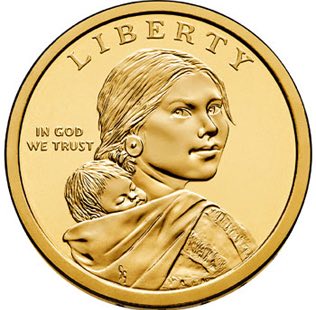Sacagawea (Sacajawea, Sakakawea), famed Native American woman whose land survival expertise and interpretive abilities were essential to the success of the Lewis and Clark Expedition, was born in a northern Shoshone village near the Lemhi River valley, in what is today Idaho. Between her tenth and twelfth year, she was taken to live among the Hidatsas of the Knife River area, modern day North Dakota.
In April 1805, Sacagawea, her husband Toussaint Charbonneau and their infant son, Jean Baptiste (Pomp), left Fort Mandan with the Lewis and Clark Expedition to explore the western lands recently acquired in the 828,000 square mile Louisiana Purchase. Considered at first to be simply Charbonneau’s wife who possessed specific native language interpretation abilities, Sacagawea became one of the most valuable members of the Corps.
Sacagawea helped supply the Corps with food foraged from the wild‚ roots, berries and other edibles. She was very calm and collected in crises and saved valuable records, instruments and other supplies when one of their boats almost capsized. Saving Clark’s journals preserved the history of the expedition for future generations. Lewis and Clark knew in advance that they would need the skills of a Shoshone interpreter when they would have to negotiate for horses to take them through the mountains. In August of 1805, west of the Continental Divide, when the expedition needed to secure horses, Sacagawea was joyfully reunited with her brother, Cameahwait. He provided horses and guides to the Expedition, assisting their journey across the Bitterroot Mountains and through the Salmon River country to the Clearwater and Columbia Rivers. In November 1805, the Corps reached the shores of the Pacific and Sacagawea saw the “great waters.”
Though her later life is shrouded in mystery and controversy, Sacagawea’s documented skill, determination, courage, and insight on the Expedition live on as an outstanding model and feat of great achievement.

